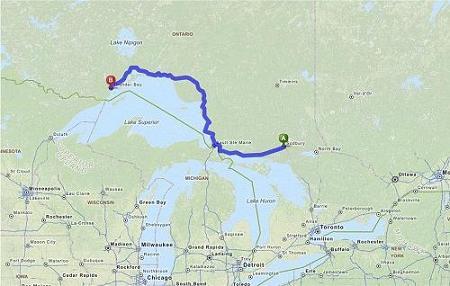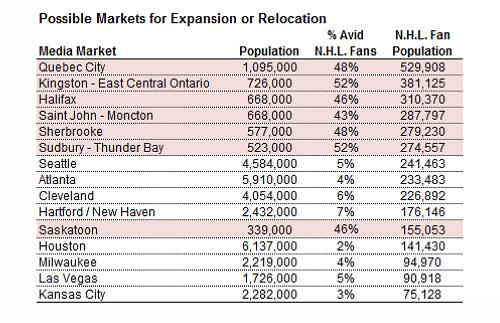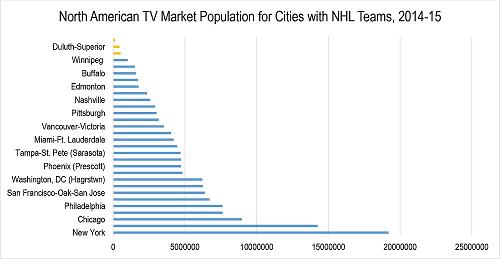NHL Expansion in the North Not Likely: A Rebuttal to the Idea of a Sudbury-Thunder Bay Market
August 11, 2015 - Talk of National Hockey League (NHL) expansion is heating up. At the end of June 2015, the league announced that it was beginning the process for expansion bids, with many speculating that the NHL would grow to thirty-two teams by the start of the 2017-18 season. The deadline to submit bids expired on July 20th, with only Québec City and Las Vegas forwarding their candidacy, along with a $10-million (USD) fee, 20 percent of which is non-refundable. A blog post featured on FiveThirtyEight, a statistical and aggregation website affiliated with ESPN, had earmarked Sudbury-Thunder Bay as a potential NHL market. Yes, you read that correctly. Could Sudbury and Thunder Bay, two cities separated by more than 1,000 km on the Trans-Canada Highway, be an ideal market for a National Hockey League franchise?

Source: Screengrab from Google Maps
Using Google trends to gauge NHL avidity, statistician Nate Silver suggested fifteen possible markets for expansion or relocation. His methodology was problematic because his estimation of the number of NHL fans in a prospective market was based on the number of times the term “N.H.L.” was searched in Google. Sudbury-Thunder Bay ranked sixth on this list, behind places like Québec City and Halifax but higher than metropolitan cities like Seattle and Las Vegas. According to Silver’s research, Sudbury-Thunder Bay had an “N.H.L. Fan Population” of 274,557 people out of a total population of 523,000. Good enough for an NHL fan avidity rate of 52 percent.

Source: Screengrab from FiveThirtyEight. Nate Silver, “Why Can’t Canada Win The Stanley Cup?” http://fivethirtyeight.com/features/why-cant-canada-win-the-stanley-cup/
The only problem is that Sudbury and Thunder Bay do not have a combined population of anywhere near half a million. He was presumably pulling from other municipalities, towns, and cities in the northeast and northwest but this is still a bit of a stretch. Statistics Canada’s 2011 census placed Greater Sudbury and Thunder Bay at 160,770 and 121,596 people respectively. This would only give them a combined population of 282,366, almost a quarter million less people than the league’s smallest market team, Winnipeg.
Even if you could overlook the way at which the article arrived at the population and NHL fan estimates (in all seriousness, how many legitimate National Hockey League fans actually search “N.H.L.” in Google?), we still have to grapple with the glaring ignorance that suggested that these two northern Ontario cities could be one market. Sudbury is actually closer to Montréal than it is to Thunder Bay and if you drove west from Lake Superior you’d almost reach the Manitoba-Saskatchewan border in the same amount of kilometers it would take you to drive eastward en route to Sudbury. Not to mention that both cities are in two separate economic districts, Northeastern and Northwestern Ontario, and are separated by three census divisions. To assume that the two largest cities in these inherently distinct regions, in Canada’s most populated province, were one giant homogenous swath of land is disconcerting to say the least.
If we wanted to actually begin assessing the case for NHL expansion or relocation to northern Ontario not only would you have to assess the viability of both Sudbury and Thunder Bay separately but it would also make more sense to start with their television markets. According to the Television Bureau of Canada, Sudbury would fall into a northeastern market that would include the cities of Timmins, North Bay, and Sault Ste. Marie, giving it 512,000 potential viewers; good enough for the 14th largest market in Canada. The Thunder Bay television market holds 149,000 viewers, placing it 25th in Canada. But to put these in perspective, if you placed them in the larger context of the North American television market they would rank 143rd and 220th respectively. Thunder Bay does have the advantage of close proximity to the United States and could potentially tap into Duluth-Superior, which contains an estimated 431,000 viewers, thereby considerably increasing the TV market pull for a Lakehead team. Nevertheless, franchises located in New York, Los Angeles, Chicago, and Toronto are also are home to the four largest television markets on the continent. Even if we assumed that the fan bases in Sudbury and Thunder Bay would be vociferously supportive, their total numbers would still pale in comparison to many of the NHL’s existing clubs.

Source: Chart compiled from the Television Bureau of Canada’s 2014-15 TVBasics Report.
There is no question that NHL fans in the region would be thrilled if the highest tier of professional hockey came to Sudbury or Thunder Bay but the reality is that neither location could support an NHL caliber team. Both places lack the television market, arena infrastructure, and corporate presence to develop and sustain a team. It is far more probable that an American Hockey League team could be iced. Some franchises in the AHL are poorly attended and could draw greater support from Sudbury and Thunder Bay over the course of thirty-eight regular season home games.
Thunder Bay has actually been in discussion with True North, owner of the Winnipeg Jets, about luring their AHL affiliate to the city. True North has been receptive to the idea as the Jets’ farm team, the IceCaps, have been located in St. John’s, Newfoundland for the last four years, posing a considerable geographical encumbrance. Beginning in the 2015-16 season, the IceCaps will move to Winnipeg, as the Manitoba Moose, and will play in the same facility as their parent club. If Thunder Bay wants to pry the Moose out of Winnipeg they will have to grab them buy the antlers by breaking ground on an events centre in the next few years. Northern Ontario is a region that contains 278 census subdivisions and is home to 803,000 people. More importantly, Sudbury and Thunder Bay are two distinct places separated by more than 600 miles. Maybe Nate Silver should have taken a trip up north, or at least looked at a map, before proposing an NHL market of Sudbury-Thunder Bay.
*As of 27 July 2015, Nate Silver or FiveThirtyEight have never offered up an explanation as to why they grouped Sudbury and Thunder Bay as one NHL market.
By Mike Commito, Policy Analyst with Northern Policy Institute
The content of Northern Policy Institute’s blog is for general information and use. The views expressed in this blog are those of the author and do not necessarily reflect the opinions of Northern Policy Institute, its Board of Directors or its supporters. The authors take full responsibility for the accuracy and completeness of their respective blog posts. Northern Policy Institute will not be liable for any errors or omissions in this information, nor will Northern Policy Institute be liable for any detriment caused from the display or use of this information. Any links to other websites do not imply endorsement, nor is Northern Policy Institute responsible for the content of the linked websites.
